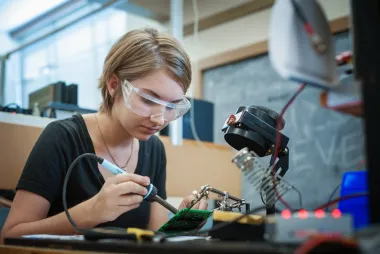Tanya Nair
- Degree:
- Bachelor of Applied Science
- Grad year: 2015
- Program:
- Campus: Vancouver
Job: Staff Machine Learning Researcher, Floodbase
Tanya Nair is building the technology and tools to transform terabytes of satellite and sensor readings into near real-time flood maps. By designing advanced models to sift through massive, datasets, she is transforming raw information into real-time flood estimates that help communities respond faster and smarter.
Did you always know you wanted to study electrical engineering?
I was fairly certain I wanted to go into electrical engineering, mainly because I knew there was a lot of math involved, which excited me. At the start of my degree, I was interested in power systems and the future of our grid—including the potential for microgrids and emerging technologies, as well as the rich technical problems associated with load balancing. Although my current work is far removed from that, those interests shaped my early academic choices.
Why did you decide to pursue graduate studies?
A master’s degree was a way for me to go deeper on the science side. I ended up at McGill, working under Professor Tal Arbel in the Probabilistic Vision Group. Grad school was different from undergrad—instead of learning how to do hard things in teams, I learned to do really hard things on my own, going deep on projects for long periods. Internships during grad school also pushed me in new directions.
What are some highlights of your work?
I enjoy the technical challenges associated with this position and that my work has a tangible benefit to society. This is where things come back to my love of engineering as an applied science: I get to work with interesting tools and develop new methods and apply them to real-world problems so that we can serve people in communities around the world.
I also appreciate that I get to work with satellite images of the Earth, which is inspiring. Seeing the aftermath of disasters is heartbreaking, but the beauty of the Earth in normal times is uplifting.
I work with a team that cares deeply about the future of our planet, and having a focus helps us make a real impact.
What advice would you give to students starting their engineering journey?
It’s okay to change your mind and follow your curiosity.
Many students—myself included—start with a rigid idea of what they want to do, but it’s important to try out different experiences and stay open to change. Ten years ago, I never would have imagined where I am now. What excites me is that I am developing and applying technology to problems that matter to people. My interests have shifted over time, from microgrids to telecom to machine learning, but the common thread is working with rich, messy data and being able to do something useful with it.





